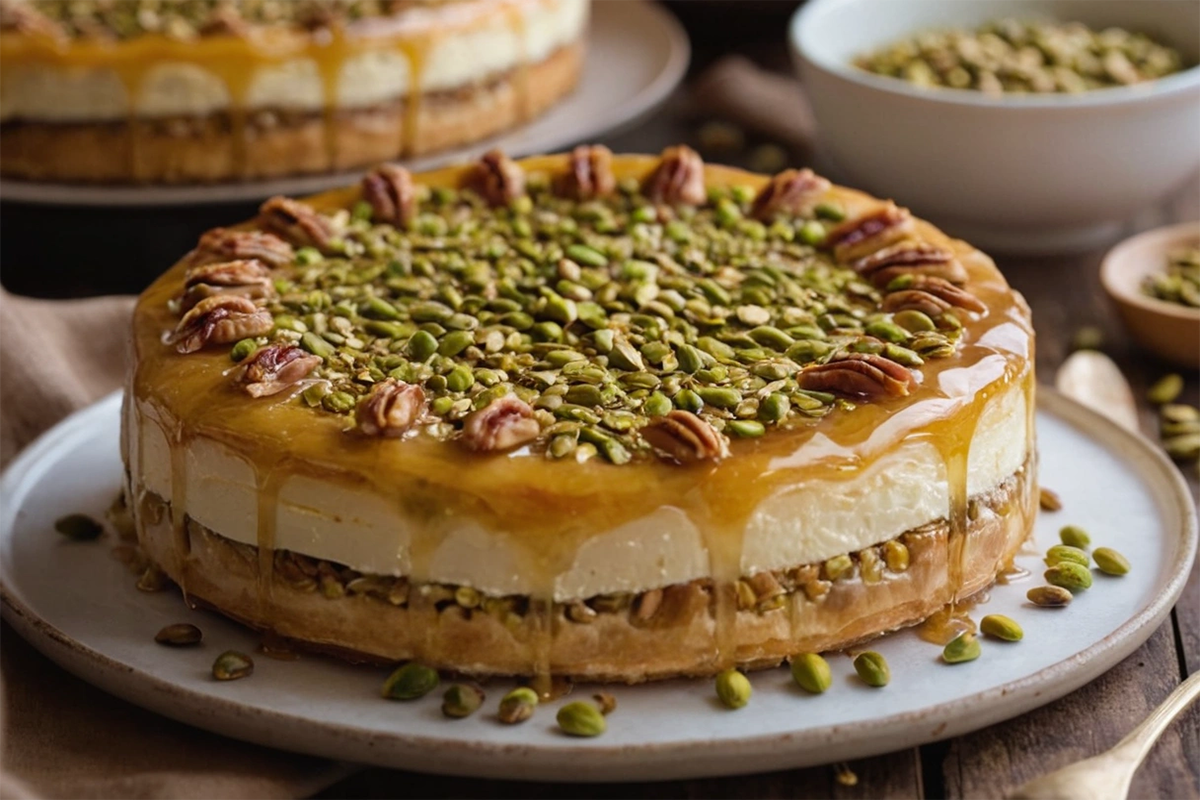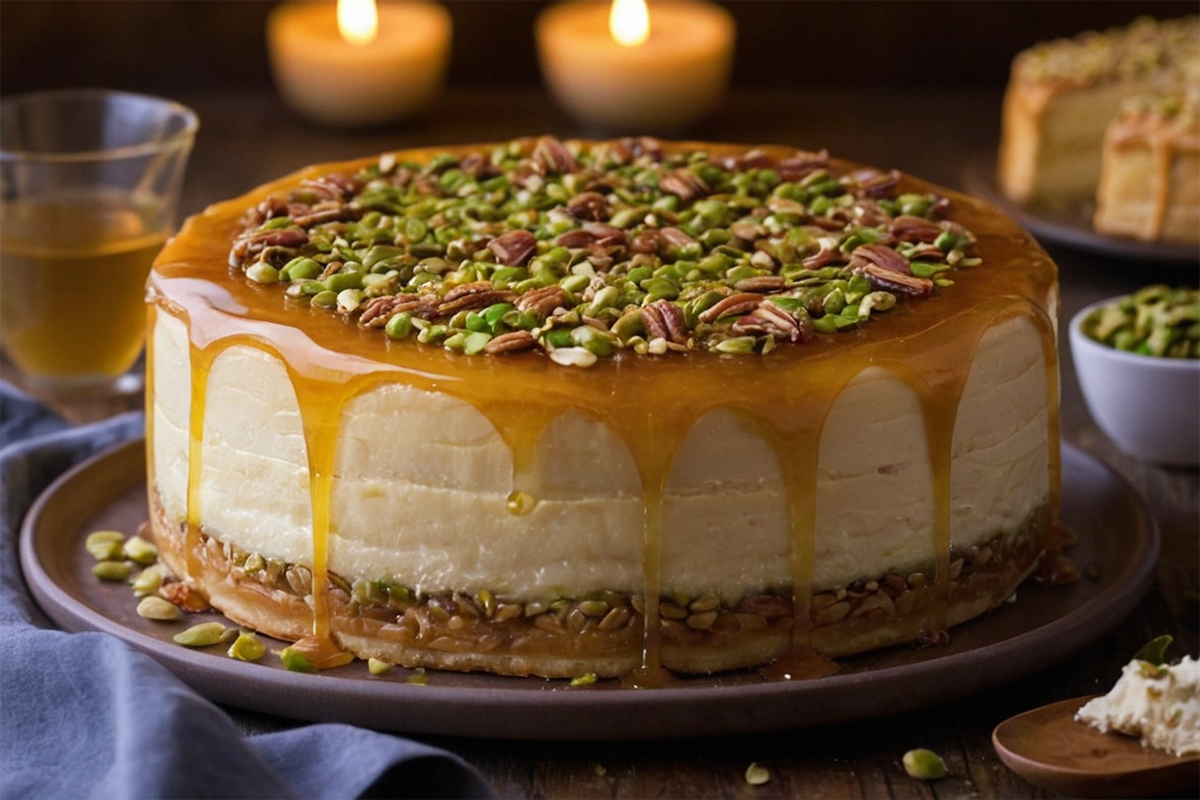This dessert is a delightful fusion of two iconic treats: baklava and cheesecake. Combining the rich, creamy layers of traditional cheesecake with the crunchy, nut-filled, syrupy layers of baklava, it brings together the best of both worlds. In this article, we’ll explore the key ingredients behind this fusion, the step-by-step process of preparing it, and the popular variations you can try at home.
Whether you’re familiar with baklava or cheesecake, this guide will help you understand the delicious synergy of flavors and textures that make this treat such a standout. For more cheesecake variations, you might enjoy reading about the Honey Pistachio Baklava Cheesecake or even a simpler twist like the Strawberry Crunch Cheesecake.
The Main Ingredients of Baklava Cheesecake
At the heart of this dessert are a few essential ingredients that give it its signature flavor and texture. Here’s a breakdown of the key elements that make up this decadent treat:
Phyllo Dough
Phyllo dough, also known as filo dough, is the foundation of traditional baklava. It consists of thin, delicate layers of pastry that are stacked and brushed with butter to create a crisp, flaky texture. When used in baklava cheesecake, phyllo dough forms the base and topping, adding a crunchy contrast to the smooth, creamy cheesecake layer.
Working with phyllo dough requires a bit of patience as it can dry out quickly, so it’s important to keep it covered with a damp cloth while preparing.
Nuts for Texture in Baklava Cheesecake (Walnuts or Pistachios)
Nuts are another integral component of this fusion dessert. Traditional baklava typically features chopped walnuts or pistachios, and these same nuts are used to add texture and flavor to the cheesecake. You can either stick with one type of nut or use a combination of both for an even richer taste.
The nuts are usually combined with sugar and cinnamon to create a sweet, spiced layer that sits between the phyllo and cheesecake.
Sweetening with Honey or Syrup in Cheesecake
Honey or a sugar-based syrup is essential to making this sweet dessert. In traditional baklava, you pour syrup over the baked layers of phyllo and nuts to infuse the dessert with sweetness and moisture. Similarly, in baklava cheesecake, you drizzle honey or syrup over the phyllo layers to add that characteristic sweetness and stickiness, making the dessert irresistible.
If you prefer a more traditional touch, opt for honey, which adds a floral note. Syrup made from sugar, water, and a touch of lemon is another popular choice for those who prefer a more neutral flavor.
Cream Cheese for the Cheesecake Layer
The heart of this creamy layer is cream cheese. As with any classic cheesecake, it provides a rich texture that contrasts beautifully with the crispiness of the phyllo and the crunch of the nuts. You’ll typically mix the cream cheese with sugar, eggs, and vanilla extract to create a smooth filling that bakes to perfection.
For those who want to experiment with flavors, you can add a touch of lemon zest or orange blossom water to the cheesecake mixture for a citrusy twist.
Eggs, Sugar, and Spices
Eggs and sugar are fundamental to binding the cheesecake filling and adding the right level of sweetness. Additionally, depending on your preference, you can adjust the sugar content to make the dessert either sweeter or more balanced. Furthermore, a dash of spices like cinnamon or nutmeg is often added to the nut layer, creating a warm, comforting flavor that pairs perfectly with the honey or syrup.
The Layers of Baklava Cheesecake
Now that we’ve explored the ingredients, let’s dive into how baklava cheesecake is structured. The beauty of this dessert lies in its layers, which combine the best elements of both baklava and cheesecake.
Creating the Phyllo Layer in Baklava Cheesecake
The first layer of baklava cheesecake is made with phyllo dough. After brushing each sheet of phyllo with melted butter, you’ll layer the sheets on top of each other to create a sturdy yet delicate base. The more layers of phyllo, the flakier the base will be. Typically, 8-10 layers are used for the base of baklava cheesecake.
Once the phyllo dough is in place, it’s time to add the nut filling.
Nut Filling
The nut filling is placed between the layers of phyllo and is typically made with chopped walnuts or pistachios mixed with sugar and cinnamon. This creates a sweet, crunchy texture that complements the smooth cheesecake. The nuts are evenly spread across the phyllo layer, creating a delightful contrast when you take a bite.
The Cheesecake Layer in Baklava Cheesecake
After preparing the nut layer, you pour the cream cheese mixture on top. You make this mixture by blending cream cheese, sugar, eggs, and vanilla extract until smooth and creamy. Once in the pan, bake the cheesecake layer until it sets.
To prevent the cheesecake from cracking, it’s important to bake it slowly and at a low temperature. You’ll also want to avoid overmixing the batter, as this can cause air bubbles to form, leading to cracks during baking.
Phyllo Topping
The final step in constructing the dessert is adding a layer of phyllo dough on top of the cheesecake. This is similar to the bottom layer but often involves fewer sheets—typically 4-6. Once layered, the phyllo is brushed with melted butter and baked until golden and crisp.
After the cheesecake has cooled, honey or syrup is drizzled over the top, infusing the phyllo with sweetness and moisture, just like in traditional baklava.
Baklava vs. Baklava Cheesecake: Understanding the Differences
Though baklava cheesecake draws inspiration from traditional baklava, there are a few key differences between the two desserts.
Preparation Time and Complexity
Traditional baklava involves layering multiple sheets of phyllo dough with nuts and butter before baking and soaking the dessert in syrup. While baklava cheesecake also requires layering, the addition of the cheesecake layer adds another step, making the preparation slightly more complex. However, many find the process enjoyable and the end result well worth the effort.
Ingredients
While both desserts share common ingredients like phyllo dough, nuts, and syrup, baklava cheesecake introduces cream cheese and eggs to the mix. This gives the dessert a creamy, custard-like texture that contrasts with the crispness of the phyllo.
Texture
The main difference between the two desserts is the texture. Traditional baklava has flaky, crunchy layers, while baklava cheesecake combines crunchy phyllo with creamy cheesecake. The syrup adds moisture and sweetness to both, and the cheesecake layer provides a smooth, rich mouthfeel that traditional baklava doesn’t offer.
Tips for Making the Perfect Baklava Cheesecake
If you’re planning to make one at home, here are some tips to ensure it turns out perfectly:
1. Handling Phyllo Dough
Phyllo dough can be delicate and prone to tearing. To prevent this, work quickly and keep the dough covered with a damp cloth to prevent it from drying out. Use a light touch when brushing the layers with butter to avoid tearing.
2. Preventing Cheesecake Cracks
Cheesecake is notorious for cracking if not handled properly. To prevent this, bake the cheesecake at a low temperature and avoid overmixing the batter. You can also bake the cheesecake in a water bath, which helps regulate the temperature and prevent the top from cracking.
3. Adding the Syrup
Be careful when adding the syrup or honey to your cheesecake. Pour it slowly over the phyllo layer to avoid oversaturating the dessert. You want the phyllo to absorb the syrup without becoming soggy, so a light drizzle works best.
4. Cooling and Storing
After baking, allow the cheesecake to cool at room temperature before refrigerating it. This helps the layers set properly. When stored in an airtight container, baklava cheesecake can last for up to 4-5 days in the refrigerator.
Popular Variations of Baklava Cheesecake
While the classic version of baklava cheesecake is delicious on its own, there are several variations you can try to switch things up:
1. Pistachio Baklava
Substitute pistachios for the walnuts or use a combination of both. Pistachios offer a unique flavor and a pop of color, making the cheesecake visually appealing.
2. Chocolate Baklava
For a more indulgent twist, add melted chocolate to the cheesecake mixture. The combination of creamy chocolate and crunchy phyllo is sure to be a hit.
3. Citrus-Infused Cheesecake
Add lemon or orange zest to the cheesecake batter for a bright, citrusy flavor that balances the sweetness of the honey.
Frequently Asked Questions (FAQs)
1. What Nuts Are Best for Baklava Cheesecake?
Walnuts and pistachios are the most common nuts used in baklava cheesecake. Walnuts provide a rich, earthy flavor, while pistachios add a buttery taste and a vibrant green color. You can also mix nuts for a more complex flavor.
2. How Long Does Baklava Cheesecake Last?
it’s lasts 4-5 days when stored in an airtight container in the refrigerator. To extend its shelf life, you can freeze the cheesecake for up to 2 months. When ready to eat, thaw it in the fridge.
3. Can I Make Baklava Cheesecake Without Phyllo Dough?
Yes, but using phyllo dough is key to getting the traditional texture. If you can’t find phyllo, you can substitute puff pastry or even create a graham cracker crust. The texture will change, but it can still be delicious.
4. Is Baklava Cheesecake Difficult to Make?
Baklava cheesecake involves several steps, but it’s manageable for home bakers. The main challenge is working with phyllo dough, which can tear easily. Keeping the dough covered with a damp cloth and handling it gently will help.
5. Can I Use Pre-made Syrup?
Yes, pre-made syrup can save time. Look for honey-based or sugar syrups. Homemade syrup is simple and allows more control over the sweetness and flavor.
Conclusion
Baklava cheesecake is the ultimate fusion dessert, combining the rich, creamy texture of cheesecake with the crunchy, sweet layers of baklava. Its unique combination of flavors and textures makes it a standout treat, perfect for special occasions or simply indulging at home. Whether you stick to the classic version or try one of the many variations, baklava cheesecake is sure to impress.
For more detailed background on the traditional baklava dessert, you can read the full article on Wikipedia.



